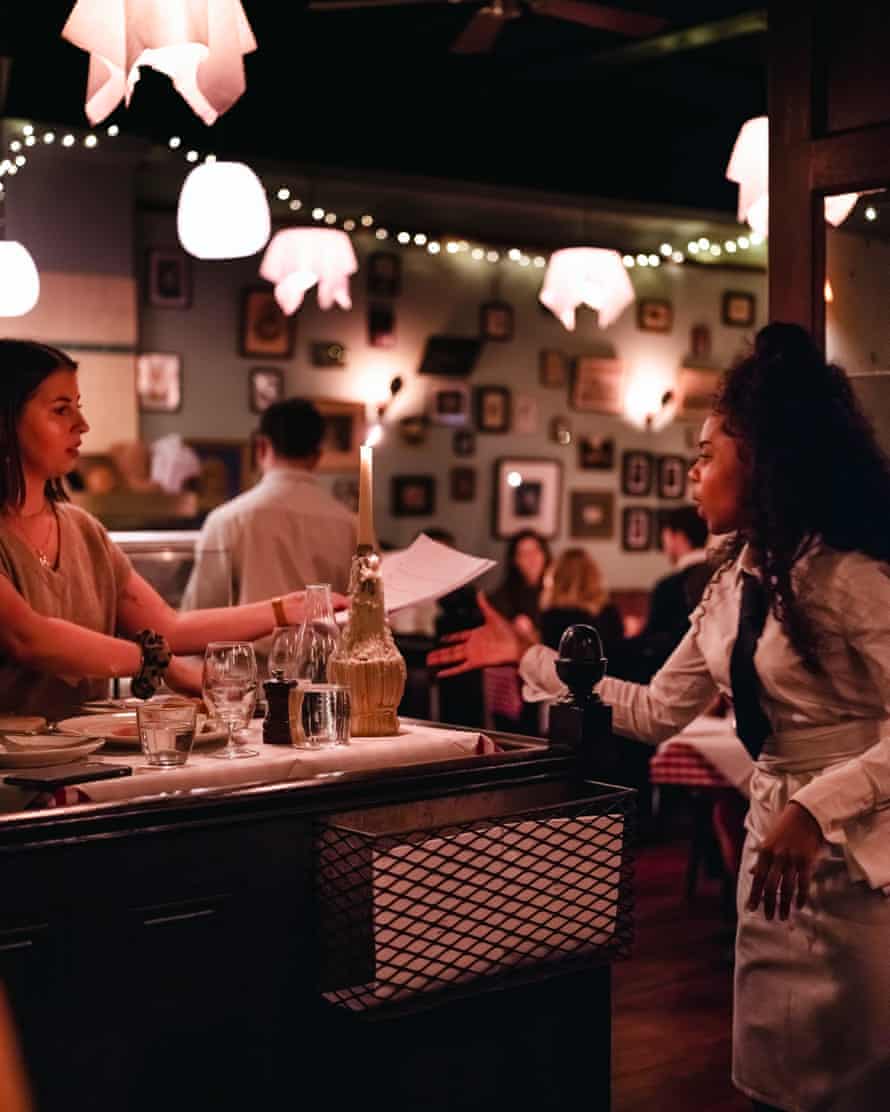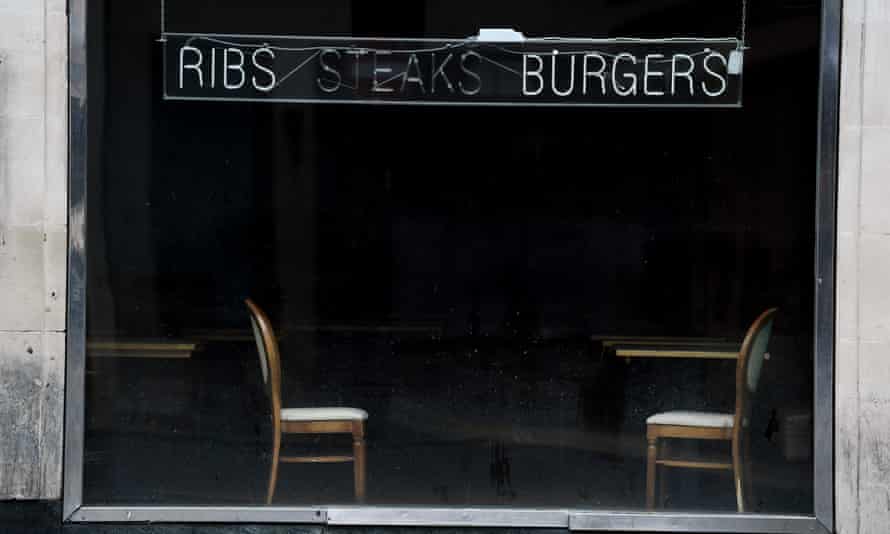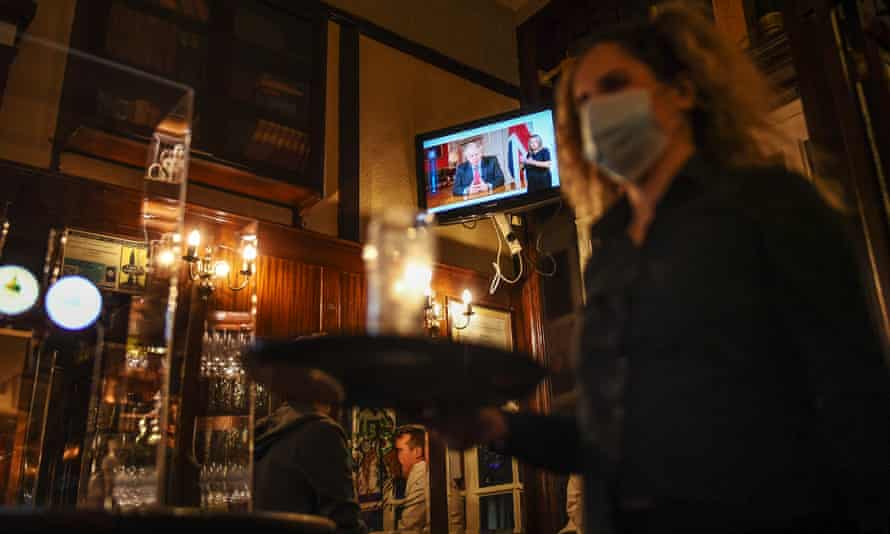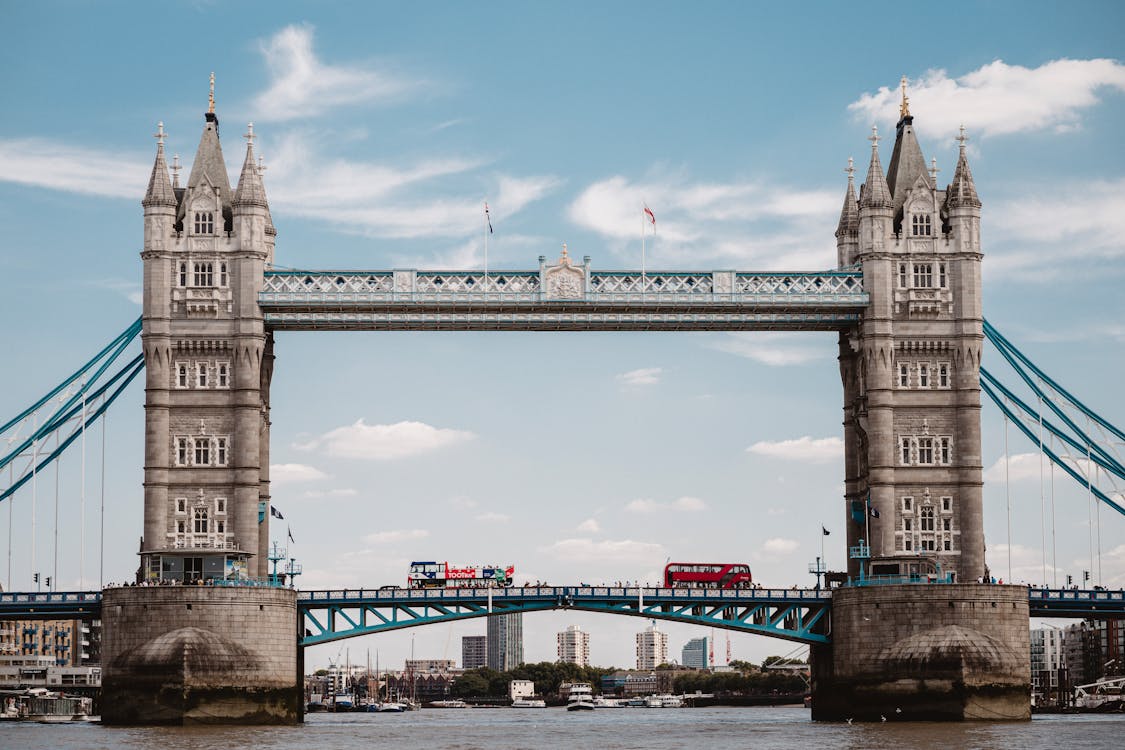Every morning last autumn, as he took the short walk from Farringdon station in central London to his new restaurant, Russell Norman came face to face with a ghost. The pandemic had hit the hospitality sector hard, and this stretch of takeaway outfits and dine-in burger chains was no exception. A Byron, a Coco di Mama, an Itsu – all long gone, doors locked, interiors dark. And then, just before the final right turn, the one that really hurt, the words on its signage removed but the outline unmistakable: Polpo.
The Venetian-inspired restaurant, which took its name from the Italian for “octopus”, had been a breakout success for Norman in the early 2010s. With its small plates, no-reservations policy and stripped-down interiors, the original Soho site had been credited with reinventing casual dining after the Great Recession. But then, like so many brands that emerged during the same period, it started to expand: taking on investors, extending tentacles across the UK, and then collapsing in instalments from 2016 onwards. Most of its sites were forced to close in the context of a broader casual dining crunch, as the cost of running a restaurant rose and the number of customers fell. These days, just two Polpos survive, in Soho and in Chelsea, west London, under the management of Norman’s former business partner Richard Beatty. Norman’s own departure from the project was finalised in June 2020.
Now, after a hiatus, he was back. For years, Norman had wanted to open an old-fashioned trattoria, replicating the homely, family run restaurants of Italy for a central London audience. A 2017 trip to Tuscany had brought his vision into sharper focus. Many of the region’s most celebrated dishes are rooted in the tradition of cucina povera (“poor cooking”), which makes resourceful use of pasta, beans, bread and offal. The food is nourishing and full of flavour, but beige and unphotogenic. In recognition of this, the restaurant would be called Brutto – or, in English, Ugly.
Get the Guardian’s award-winning long reads sent direct to you every Saturday morning<br>
Almost from the start, the name felt less like a clever, self-confident nod to Tuscan gastronomy – Tuscan food is not just ugly, it is “ugly but good”, brutto ma buono – and more like a description of Brutto’s own fortunes. The past two years have been the hardest in living memory for restaurateurs. Brutto was supposed to open in June 2021, but the global shortage of construction materials delayed it until autumn. A further delay to the completion of the kitchen had left the head chef, Oli Diver, little time to develop the menu for opening day. Brexit had made it difficult to recruit staff. Brexit- and pandemic-related disruption had made it nearly impossible to secure crucial ingredients. When I first visited the restaurant in late September 2021, Britain was in the midst of a fuel crisis and the queues at the petrol stations were at their longest. The shortage of lorries with drivers and full tanks meant that the bar – intended to be a space where local people could pop in for an espresso – would have to get through its first few weeks without any coffee cups.
The Norman I met was a macchiato-sipping, cigarette-smoking caricature of an anxious restaurateur. But he also seemed perversely thrilled, vibrating with the nervous energy of someone facing an enormous challenge. His highly caffeinated sentences tripped over one another, offering abundant rephrasings, clarifications and reformulations. He was dressed in his typical attire: a mixture of slightly rumpled continental tailoring, open-collar shirts and Chelsea boots, as artfully dilapidated as a restored Florentine palazzo.
This was, he calculated, his 31st restaurant opening. Most of the first 15 had come as he worked his way up through the ranks at Caprice Holdings, a hospitality industry behemoth that specialised in central London restaurants in which rich people unthinkingly parted with large sums to enjoy pristine shellfish (Scott’s), haute nursery food (The Ivy), or high-grade protein wrapped in gold leaf and garnished with caviar (Sexy Fish).
Polpo, which opened in 2009, was different: the room was dark, the décor distressed. But before long, the queue snaked out the door; punters packed the bar as they waited for their table. Its instant success earned Norman a slew of adulatory headlines – ‘the coolest man in food’; ‘the new king of Soho’ – and introduced many Londoners to concepts like small sharing plates that would soon become ubiquitous.
Polpo targeted a younger crowd, but Brutto would be a broader church, welcoming dog-owners, parents with babies, older couples; its backstreet location gave it the cachet of a neighbourhood restaurant. Still, the parallels between the two restaurants were unavoidable: the focus on regional Italian cuisines, the playful two-syllable names, the fact both were born into a time of crisis. All of which made the proximity of the shuttered Polpo seem like a warning. It was a constant reminder of how most restaurants end.
The economics of running a restaurant pre-pandemic were not favourable – even before Covid, restaurants in the UK went bust at three times the rate of other businesses – but they were at least familiar and, with good management and luck, survivable. Now, mid-pandemic and post-Brexit, Norman was operating in a new economic reality. The pandemic had wiped out one in 10 of Britain’s restaurants. When we spoke in September, as much as he was excited about the next few weeks, he was realistic about how they might conclude.
“The pressure in business terms running a restaurant is always the first month,” he said. “There’s a massive, massive capital outlay and you don’t get any money coming back into the business until a good week and a half after you’ve started to operate – partly because most restaurants open with a preview period where everything’s discounted 50%, which means you’re not making any money at all, just about covering your costs. So that first month is critical. A lot of restaurants fail because they literally run out of money, it’s as simple as that.
“If things aren’t great, if it’s not a hit from the beginning, I’m going to have to look to borrow money in order to keep it afloat. And that’s where it gets scary.”
A new restaurant is a precarious business venture, but to start with, it is also an empty stage. Before he found his home in restaurants, Norman had worked as a council arts administrator and then as drama teacher at a north London school; he is still, unmistakably, a thespian, from the way he works a room to his flair for circumlocution. And as much as he cared about Brutto’s financial success it was clear that the artiste manqué in him was just as focused on the aesthetics of the thing. Early in our time together, Norman professed: “I don’t think of myself as an entrepreneur, I think of myself as a creative.” Running a restaurant was not so different from putting on a theatrical performance – tellingly, Norman referred to Brutto’s very first service as a “technical rehearsal”. Spurred by past failures to fully realise his vision – “I was trying for Bohemian Rhapsody but I ended up with the Birdie Song” – with Brutto he was exacting.
Push on the front door with its Italian blue-and-white spingere sign, and inside, everything is as precisely curated as the restaurant’s 18-and-a-half hour Spotify playlist (a mix of Pitchfork-approved rock, lo-fi electronica, and a lot of Everything But the Girl). Lampshades fashioned from napkins float from the ceiling like tiny ghosts; tables are dressed with red-and-white checked tablecloths and candles wedged into chianti bottles. One wall is given over to framed portraits, photographs and still lifes, a nod to the decor of Florentine favourite Trattoria Cammillo; another is covered by a cacophonous mural by artist Neil Fox – Bosch’s Garden of Earthly Delights populated with uncanny-valley celebrity portraits and 20th-century pop culture arcana (is that Christopher Hitchens? Damien Hirst? Chet Baker?; that’s definitely Mickey Mouse, King Kong and Captain Haddock). If the inspiration for Brutto was a traditional Tuscan trattoria, the end result is 90% earnest homage and 10% high-camp pastiche.
As Norman and Diver worked together in the weeks before Brutto opened, they ran into problems in realising his very specific vision. To stock the restaurant, they relied on a diffuse network of suppliers: about 20 different outfits provided ingredients for Brutto’s kitchen; a further 15 or so provided the linen, crockery, glassware and other bits and pieces used in the dining room; another 20 serviced the restaurant’s well-stocked bar – six or seven wine merchants, then separate sources for traditional Italian aperitivi and amari like Select and Fernet-Branca, plus soft drinks and beer. All in all, Norman calculated, “60, 65 individual suppliers just to open a restaurant on a Tuesday”.

But finding the suppliers was tricky. The pandemic had forced even some of the biggest names in hospitality to downsize or shut down entirely. “About 80% of the bread suppliers we tried to contact,” Diver recalled, “Google search: permanently closed”. Those who survived were struggling with their own supply chain issues, and insisted on weekly payments, rather than the old industry standard of 60 days – agonising for a restaurant not yet producing a reliable cashflow. Even those suppliers that had stock available were running into problems. “One said they had a three-month wait time because they had no drivers, and the drivers don’t have fuel,” said Diver. “You’re expecting things to be like ‘Yep, we’ll have an account for you next week’ and instead you’re like ‘OK, so I can’t get any of that for another three months now’.”
Across the country, restaurants were suffering in similar fashion. In the month before Brutto opened, Nando’s was forced to close about 50 of its branches as it faced the prospect of running out of chicken. Another poultry giant, KFC, warned customers to expect shortened menus and packaging that “might look a little different to normal” as it struggled to secure supplies of food and materials. McDonald’s reported a shortage of milkshakes and some bottled drinks. Pizza Hut ran out of ice-cream in the same week as Wetherspoon’s suffered nationwide beer shortages. And it wasn’t just fast food and pub chains: in a survey conducted by Deliveroo last year, 89% of the small and independent restaurants on its platform had seen wholesale costs increase, and 54% had removed items from their menus owing to a lack of availability.
Given the context, even a generic pizza and pasta joint would have been challenging to get off the ground. But the task at Brutto was complicated because it took its inspiration from Florence, a city of arcane and singular culinary traditions that include lampredotto (stewed cow’s stomach), cibrèo (a stew of rooster testicles, crests and wattle) and pappa al pomodoro (a cold tomato soup thickened with chunks of stale Tuscan unsalted bread). Norman had wanted the menu on opening day to feature a dish of wild boar sausages with lentils, but no wild boar could be found. The bread supplier was unable to offer a crusty white roll of the kind typically used in a sandwich stuffed with lampredotto; the lampredotto itself had to be shipped in from France. Except the French suppliers only sold it 20kg at time, so Brutto also had to buy a separate freezer, purely to store the vast slabs of offal.
It wasn’t always this way. When Norman opened Polpo, he had far less trouble in securing outre fare like baccalà (salt cod) and moscardini (tiny baby octopuses). But these days, the economic pressures of the pandemic and the post-Brexit difficulty of getting produce into the country has forced suppliers to cut their offerings to only the guaranteed bestsellers. “The niche stuff, the suppliers just don’t bother with,” said Norman. “So what you end up with is a choice of goods which is really basic.”
It wasn’t just supplies that were scarce. So, too, were staff. The key lieutenants had come together quickly: general manager Monique Sierra and the restaurant manager, Alexis Ross, had worked with Norman before. In the kitchen, Diver had been recruited from the well-regarded modern European restaurant Allegra, with the promise of his first head chef gig. But after this, they spent weeks hunting for a qualified deputy to Diver, a team of three or four chefs de partie, and a further three or four front of house.
On 27 September, two days before Brutto’s first dress rehearsal, Norman posted on the restaurant’s Instagram account a sketch of a chicken standing on a restaurant table in front of a bemused customer. The caption read “There’s not enough staff, so you’ll have to cook me yourself”. Subsequent posts would include a list of vacancies that still need to be filled – amounting to practically the entire staff of the restaurant.
Sierra – “Russell’s representative on Earth,” as one waiter described her – led the recruiting effort for front-of-house staff. “To be blunt,” she told me, “all the people who love working in restaurants are hard to find here at the moment, because they’ve all gone home”.
The impact on the industry was brutal. Industry platform Big Hospitality reported that 660,000 jobs disappeared in 2020. And then, as businesses sought to rebuild last year, they found workers in short supply. “When the uncertainty started to ease, the market just went crazy with outbidding and competing with each other,” said Joanne Searley, operations director for JKS Restaurants, which owns 20 establishments ranging from the fast casual Bao in Borough Market to the two Michelin-starred Kitchen Table in Fitzrovia. In December 2021, JKS Restaurants found itself with more than 300 vacancies to fill.
Chefs and operators agreed that this was an unprecedented crisis. “It’s definitely the worst I’ve ever seen,” said Tom Anglesea, an acclaimed chef who has spent the best part of 18 months attempting to assemble a team for a new project in Mayfair. “You look, every week there’s new openings – and there’s just not enough manpower to go around, you know?”

In an industry notorious for its exploitative and abusive workplace culture, the sudden scarcity of staff placed power in the hands of cooks and waitstaff who had long been treated as fungible. At the multinational chains like McDonald’s and Chipotle, food service workers put pressure on their employers to improve working conditions and wages.
“It’s an employee’s market really,” said Mandy Yin, who runs the celebrated Malaysian restaurant Sambal Shiok in north London. “There’s been high turnover since reopening last year with many choosing to leave the industry altogether – a much smaller pool of available staff.”
It also led to fierce competition, especially when it came to hiring kitchen staff. “There have been lots of attempts to poach key team members,” lamented Crispin Somerville, an industry veteran of 25 years who co-owns a London-based restaurant group including Quo Vadis, Barrafina and El Pastor. “It’s definitely got much more cut-throat out there.” In June 2021, the Italian restaurant Ombra – based in east London, but casting around for cooks in the same pool as Brutto – announced via Instagram that it would be closing on Tuesdays and Wednesdays until further notice, blaming a “major shortage of staff both on the floor and in the kitchen caused by the brutal trifecta of the pandemic, Brexit and a wasteman poaching some of our team.”
As he tried to set up Brutto’s kitchen, Diver quickly became acquainted with the brutal trifecta. He took to advertising vacancies on industry job boards, paying up to £200 per post for negligible returns. Even promising leads had a habit of crumbling to dust. “Ten per cent of [chefs] you try to get in contact with will turn up,” he began, before pausing to correct himself. “No, less, less. 10% say they’ll turn up, 5% turn up, 2% are fit for the job, and you’ll say ‘OK, well let me know what you think in a couple of days’, and they’ll come back to me and say they’ve been offered a sous chef job somewhere else for about £35,000.”
In the weeks building up to opening day, Russell’s brother, Lloyd, was called into action in the kitchen, despite having no prior culinary experience. (Even someone relatively unskilled can be useful: any time a chef is not chopping onions or peeling potatoes, they can spend on more complex tasks.) For front-of-house, “Hire on the basis of attitude rather than experience” became the motto. Among the new hires was Ryan Petersen, a former theatre publicist who had not waited tables for two decades. (“Russell took a real chance on me,” he said.) Meanwhile, Diver tailored his menu to take account of an understaffed, underskilled kitchen, rejecting labour-intensive tasks like preparing fresh pasta in-house and focusing on dishes that could be prepared, as much as possible, before service began.
One dish that could not be prepared in advance was the legendary bistecca – a giant T-bone steak that represents one of the cornerstones of Florentine gastronomy, cooked over flames and served bloody, like something out of Dante’s Inferno. Norman had a provisional arrangement in place with a supplier, but was always looking for ways to shorten his supply chain. The day before opening, an opportunity presented itself, courtesy of the Flat Iron Steak founder Charlie Carroll: would Norman be interested in a supplier based just metres away in Smithfield market, who could provide him with the giant 15kg loins from which the Bistecca would be hewn? Norman jumped at the chance, and hours before his new project opened its doors it was possible to see the onetime king of Soho strolling through Farringdon with the best part of a dry-aged cow slung over his shoulder.
It was chancy, last-minute stuff, but it worked. Through the technical rehearsal on Wednesday 29 September and a series of soft opening services in the days that followed, customers came and went and the whole shaky edifice did not topple over. Partly, this was due to carefully managing the number of orders – no more than 15 every half hour was the sweet spot that kept punters happy without overloading the kitchen.
“I was pessimistic and had many prepared apologies up my sleeve should things go wrong,” Norman told me the following Monday. But disaster had not struck. “At the end of each service we all looked at each other and thought ‘My God, we did it, it felt like a real restaurant!’”
Before Brutto opened its doors, Norman had planned for all the predictable things – wages, food bills, rent – but one unknowable was how much each punter would be willing to part with. Brutto’s pricing was London mid-market: more expensive than an Italian casual dining mainstay like Franco Manca, but a long way off the capital’s Italianate heavy hitters like Locanda Locatelli or Murano, where dinner with wine could run to hundreds of pounds per person. Norman had therefore originally budgeted for a spend of £40 a head, enough to cover a starter like coccoli (fried dough “cuddles” served with prosciutto and tangy stracchino cheese); a pasta like the tagliatelle ragù, winkingly undersold on the English menu as “pasta with meat sauce”; a glass of wine and a coffee.
But the Brutto Instagram account from the time, with its photos of the bistecca blackboard – its offerings systematically crossed out as customers order steaks costing £62, £70, £75, £80 – demonstrated how readily punters were parting with their money. Lots of people were coming in: local designers, new mothers, camera-happy food dorks – all of them spending more on food and booze than Norman had expected (the figure per head, in fact, was closer to £70). Sierra spoke in awed terms about the gentleman at table 49, a prodigious consumer of negronis, champagne and brandy who would come in for lunch and take down an entire bistecca and bottle of wine by himself.
“I think it’s working,” Norman told me on a rainy day in early November. “The restaurant has a very good chance of survival.” But he also admitted that the kitchen was running on fumes, and the challenge of finding enough people to get Brutto off the ground had now become the challenge of finding reinforcements to give the vanguard time to recover. A typical kitchen might expect to manage with a head chef and a handful of sous chefs working on rotation, but in Brutto’s early days Diver had to churn through 90-hour work-weeks with only his senior sous chef Alan Williams (and Norman’s brother, Lloyd) for company. Diver was phlegmatic – “I’ve never worked in a kitchen that’s calm and relaxed” – but with no days off and no end in sight, he seemed to be hitting his limit.

There were two principal problems. The first was time. Diver’s strategy of lightening the load on the kitchen during service meant that a huge amount of prep had to be fitted into the remaining hours. Carrots, onion and celery had to be chopped and simmered down into soffritto, the aromatic base for the soups and meat ragùs that are central to Tuscan gastronomy. The sauces themselves had to blip and bubble for hours before they could be set aside, decanted and refrigerated for later use. It was impossible, at the start of the week, to do all the necessary prep for the 10 services ahead (lunch and dinner, Tuesday to Saturday). The fix here was easy, though painful financially: from 14 October, Brutto would be closed on Tuesday lunchtimes.
The second issue was gnarlier. Up to this point, front of house had tried to keep things manageable for the kitchen by limiting numbers in the dining room. Occasionally, it would be the customers who lost out: amid positive online reviews, there was a small but voluble subset of Tripadvisor reviews decrying long wait times for a table, or how front-of-house had handled them in their disgruntlement. Now that the restaurant was up and running, Norman wanted to increase the number of covers. “We’re serving more than 130 people a day and we could definitely do more,” he told me. “This is a finely balanced mathematical machine.” The margins between success and failure, profit and loss, were razor-thin.
“It’s a constant worry for me that I’m going to burn my chefs out because demand is so high,” Norman said. His hope was that he had bought enough goodwill from his staff to get through the gruelling first few months. “Everything has been collaborative and so they are completely invested in it, and even though they grumble at the end of the shift, ‘Oh my God, that was tougher than I expected’ I say look, guys, come on, here’s a beer, here’s a second beer, let’s talk about it. We have to push on. We need more staff, we need more prep chefs – we’ll get there. It’s hard work at the moment but I promise you – you will be rewarded.”
Despite mounting stress, I wasn’t aware of any blow-ups in the kitchen. “[Diver] is just so calm all the time,” Sierra said. For Petersen, who had last worked front of house in the days of Gordon Ramsay and Marco Pierre White, the difference was striking. “The old notion of the bully and shouting chef does still exist – we know this – but it doesn’t happen here. The kitchen isn’t a scary place for a waiter to go.”
And, in time, Norman’s optimism and the kitchen’s perseverance were vindicated. In Brutto’s opening weeks, Norman had fretted that people might not “get” it: that they would come expecting Polpo 2.0, or something MasterChef-flashy, or Michelin-star precise. He emphasised how Brutto’s inspiration was family run trattorie, that the food could be strikingly simple: a plate of raw cabbage, seasoned with lemon and olive oil; bitter chicory puntarelle, dressed with garlic and anchovy. Still, Norman was perhaps overanxious about managing customer expectations. Pasta, £5 negronis and decent music was an easy enough concept to “get”.
And people clearly got it. Good reviews kept appearing in the newspapers. One night, the Michelin-starred celebrity chef Jun Tanaka visited, and went into the kitchen after service to pass on his congratulations. Websites regularly scoured by London’s foodies began to include Brutto on rankings of the city’s hottest restaurants. Its booking policy – nothing taken further than 14 days out, with reservations for the 14th day released at 9.30am on the dot – created further demand. As Brutto’s fame spread, so did the number of chefs interested in working there. After spending thousands on recruitment ads, Diver now had chefs coming to him.
By early December, the team was as jubilant as I had seen it. Norman had shaved his head in the spirit of “fuck it” when things had been at their most parlous; now it had started to grow back, he no longer looked like a condemned man. On one of the days I visited, it was his birthday and the team had banded together to get him a smart Missoni tie that he immediately put on in place of the one he had been wearing. He was quick to credit his young crew for all Brutto’s recent success, pointing out Lily, a 19-year-old waiter now running her own section of the restaurant with the elan of a seasoned veteran; and Filippo, a part-time waiter who alternated studying for his politics degree with stints in front of house, adding observations about what real Tuscan food looks like (“It’s not a real bistecca if it’s under a kilogram”).
The buildup to Christmas was well under way; business was booming; life at Brutto was, for the first time, unambiguously buono. Norman couldn’t resist a joke, as I prepared to finish reporting for the day. “I guess,” he said, “you need more jeopardy.”
We did not have to wait long. As the Omicron variant took hold around the globe, the UK government announced on 8 December that it would be tightening Covid-related restrictions and recommended that everyone work from home if they could. It was a painful blow for Brutto, which relied heavily on custom from the offices and studios around it.
But, when I spoke to Norman in the week before Christmas, it was more what the government wasn’t doing that was the real source of anger. “There doesn’t seem to be any joined-up thinking,” he lamented. Like many other restaurants in the UK, Brutto was on a precipice.
The run-up to Christmas is traditionally the busiest time of the year for the hospitality industry: pubs host raucous team drinks; restaurants cater to team lunches or office parties. But now, customers were spooked. Things were especially bad in London, where diners were down to 57% of their 2019 volumes; bookings at Brutto were down 40% on usual levels as the threat of another lockdown lingered.
Then again, a lockdown would at least have represented some clear action. What was so punishing about the current situation was the barrel was being drained without anyone in the Treasury prepared to top up the shortfall. “It’s just so frustrating that it’s neither one thing nor the other,” Norman said. “Because there’s no edict from the government to close down hospitality, there’s no support.”

It felt like a return to Brutto’s early days, with a skeleton staff trying to make do, and financial disaster constantly hovering, as fixed costs – wages, rent, taxes – continued to demand attention even as takings dwindled. “It’s not just day by day, it’s hour by hour,” said Norman, as he nervously awaited another batch of lateral flows. “If one of them comes back with two lines, it’s game over.”
Norman and his lieutenants agonised over the number of staff available, gaming out different scenarios. Could they just open as a bar? Serve cold food only? With a future lockdown still a possibility, could Diver really take the risk of ordering a week’s worth of supplies if they were going to end up unused? Hospitality margins are thin: a day’s ingredients cost about £3,000; Brutto’s profit from the 10 weeks since it opened were only three or four times that. The restaurant could be plunged into the red with a single ill-judged shopping spree.
Bit by bit, the number of healthy staff dwindled into single figures. In a two-week span, more than three-quarters of them had contracted Covid. In the end, it was inevitable: Brutto closed its doors for Christmas on 21 December, three days earlier than planned.
Brutto was not alone in its suffering. Omicron had cut a swathe through pre-Christmas festivities. One of the many restaurants that closed early was the Quality Chop House, just up the road from Brutto in Clerkenwell. Its co-owners, Daniel Morgenthau and Will Lander, made the proactive but painful decision to close on 16 December. “We just had this impending sense of doom,” explained Morgenthau, citing increasing Covid cases among his staff and declining guest bookings. The closure took its toll: “I think it was three weeks that we were paying full salaries and full rent with no government support and no trade – that cost us significantly, not least because that would historically be our best period of trade of the year.” The trade body UK Hospitality would eventually estimate that the combination of fewer bookings and early closures would cost pubs, bars and restaurants an average of £10,000 each.
And now it was January, a month dreaded by restaurateurs. The first month of the year is always a tough sell as customers are recovering from overeating and overspending. But it soon became clear that it had been fear of missing Christmas – rather than Omicron itself – that had been the real deterrent. Now that customers no longer had to worry about a positive test forcing them to cancel Christmas with loved ones, they began to return to the restaurants they had been so studiously avoiding.
On 7 January, I paid a visit to Brutto, to find the team in good spirits once again. The first few days back had been better than expected, and another lockdown seemed less likely by the day. There were still staffing issues – Filippo was stuck in Italy, owing to the latest round of border closures – but there had been enough of the core team fit and healthy to reopen earlier that week, and enough part-timers keen for a few extra hours to fill the gap. As the restaurant slowly built towards service – a wine delivery decanted on to shelves, bread ferried over to the service station – Norman’s new puppy, Twig, nosed its way around the unfamiliar floorboards.
For Diver, the Christmas break had come at an opportune time, giving him a chance to recharge. Forty minutes before lunch service, he had already put in a shift in the kitchen, but was full of energy, singing the praises of a soon-to-be-delivered pasta boiler, which would both simplify one of the kitchen’s most boring-but-important tasks and free up some much-needed space on the hob. “It constantly tops itself up,” he rhapsodised. “It’s going to be such a dream!”
There was a broader optimism, too, a sense that there were finally enough spare hands to deliver the restaurant as originally envisioned. Since launch, Brutto’s menu had barely changed. The first order of business was to start mixing it up a bit, better to channel the spirit of the Tuscan restaurants that inspired the place. “The menu was going to be seasonal, changing,” Diver said. “That was always the idea, but over the last few months there’s been no time to think.”
At last, he had the time – and the staff – to do it. He walked back downstairs to show two new trainees the basics, preparing them for life at Brutto. Diver told me that the previous day was the first time they had actually been prepared for dinner service before it started. By 5.30, they were ready, and a new and uncertain peace had descended. “People were asking me what to do,” Diver said. “And I was like: just wait for the customers.”






More Stories
India’s macro and micro cuisines underappreciated Masterchef changing that notion, states Vikas Khanna
Students Go on Planet Food Journey as Chartwells K12 Adds New Places to its ‘Global Eats’ Method
Globe Cuisines That You Will have to Test In Italy